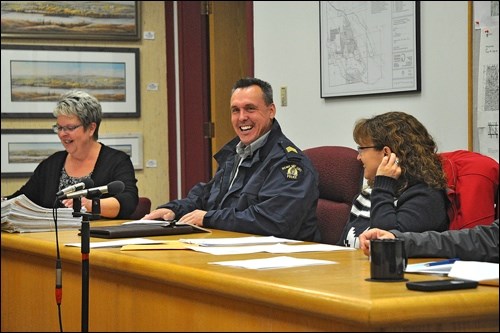S/Sgt. Darcy Woolfitt presented the quarterly crime statistics to the Battleford town council Monday, reporting calls for service basically remain the same compared to 2014.
There has been an increase in person and Criminal Code offences but property offences have decreased, said Woolfitt.
At the end of the third quarter, there were 696 calls for service to date this year compared to 699 to date last year.
In Battleford, to the end of September of this year, there were 69 person offences, seven business break and enters, seven residential break and enters, 220 property offences, 64 criminal code offences, seven drug offences, 16 Liquor Act offences, 17 motor vehicle collisions, 111 provincial traffic offences, 18 impaired operation of motor vehicle offences, nine municipal bylaw offences and 32 calls for other assistance.
Woolfitt, who was recently promoted to staff sergeant in charge of operations and is second in command of the detachment, also told town councillors school liaison officers have been making regular visits to Battleford schools to interact with students and staff. For the month of September they were in touch with schools to update the School Safe plans and to perform proactive school zone patrols, he said.
The documentation presented to council also included a report by Insp. John Sutherland outlining the detachment's Intelligence Led Policing model. In that report, he said the Battlefords detachment is an extremely busy detachment where the majority of calls are driven by individuals who have drug and alcohol dependencies.
Woolfitt said, "We see a lot of that in our day-to-day policing."
The detachment is about six months into the three-year policing plan created by the inspector and other members of the detachment.
"It was developed at the detachment. Inspector Sutherland is leading the charge on that," he said.
The calls for service at the detachment are influenced by two main factors — violent crime and anti-social behaviour such as persons crimes, property, drug associated crimes and mental health and addictions problems.
"That is an area where a lot of our work comes from," said Woolfitt.
By shifting focus to the ILP model as a change in service delivery, the RCMP plans to enhance the success of crime prevention and reduction, improving the quality of life for those with social and addictions issues, increasing frontline policing effectiveness and improving public safety. Functional and aggressive initiatives will be implemented over the course of three years to achieve the plan's full potential, Sutherland wrote in his report.
"There are a lot of initiatives going on right now," said Woolfitt, "not only involving police but involving many other agencies within the Battlefords working together in order to reduce crime and help these people who have addictions and mental health problems have a better quality of life as well."
The ILP will support community policing strategies and harm reduction by targeting emerging and existing crime trends and persons responsible for committing crime by focusing on repetitive offenders and others responsible for criminal activity.
"The people that we deal with regularly, we will continue to work on crime reduction initiatives by focusing on their activities," said Woolfitt.
If they are on any kind of release conditions, it becomes a priority to track and monitor them to make sure they are abiding by the court-imposed conditions, and if not, to make sure the breaches are dealt with.
"By targeting those people it's also helping us drive that crime rate down," said Woolfitt.
Within the ILP model, service delivery is to be enhanced and fostered by the increase and functionality of intelligence reports on crime and associated events and the relevant deployment of resources, as a direct result of statistical and analytical data.
"We're going to be really focusing on and using analytical resources to target where we need to be doing more work."
The detachment has access to an analyst and they are trying to get one full time, said Woolfitt.
"That's part of the policing plan, to put some of these people in place so we can utilize their skill sets."
The goal of the ILP model it to implement creative and intelligence led initiatives to support a commitment to keeping the community safe while remaining cognizant of getting the greatest value from money and assets.
"I'm hopeful that as we continue to work on this we will see the crime rate go down," said Woolfitt.
At the end of the three-year plan, they will be able to look back and draw a road map of where to go from there, he added.
When asked if there was a possibility the Battlefords model would be imported to other communities, Woolfitt said, "Potentially."
He added, however, "Our focus right now is the Battlefords, to see what we can do here. We also look at what’s going on in other communities ... if there is something working somewhere else we can use as part of our policing program."
What Mayor Derek Mahon described as the "superwatch" is part of the plan, Woolfitt confirmed.
With separate watches for rural, city and town in the past, there was always a certain disconnect, he said. Now the Battlefords has an inspector back at the detachment, the model is to bring everybody together for the four daily watches. There's a mix of rural and urban on each watch, he explained, in part because some of the people causing problems in the urban area are also causing problems in the rural area.
"It's a positive improvement," said Woolfitt.
As regards crime specific to Battleford, the mayor said the newest trend is joyriding garbage cans into vehicles.
In one particular neighbourhood, $15,000 in damage was caused by the joyriding of garbage containers and compost containers.
"The officers are well aware of it," said Mahon.




